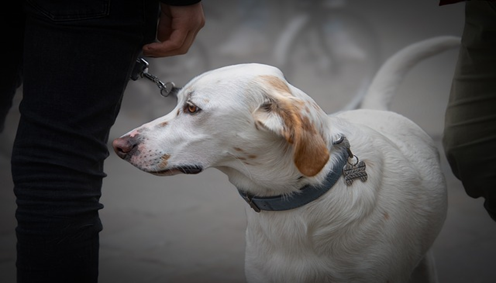Devin Harris of Joplin, MO is the owner of Great Danes of the Ozarks, a reputable Great Dane breeding program in Missouri. Great Danes of the Ozarks specialize in breeding healthy and well-tempered Great Dane puppies with a focus on quality over quantity. Their breeding program follows strict guidelines and standards to ensure the health and happiness of their dogs. Owning a Great Dane comes with unique challenges and responsibilities, especially when it comes to navigating public spaces. In the following article, Devin Harris delves into the intricacies of Great Dane etiquette, offering insights into leash mastery, physical and mental preparation, space awareness, and positive interactions with other dogs. Below is an exploration on the key elements that ensure both you and your gentle giant navigate public spaces with grace and consideration.
Great Danes of the Ozarks Discuss Mastering the Leash: The Foundation of Public Etiquette
Great Danes are a beloved breed, known for their amiable disposition and impressive size. However, their size also means their behavior must be managed in public spaces to ensure their safety and the safety of those around them. For any giant dog owner, becoming proficient in leash handling forms the basis of public etiquette.
Choosing the Right Gear
The key to mastering public spaces with your large breed begins with choosing the right gear, and the leash is your primary tool. Consider investing in a leash that strikes a balance between strength and comfort. Great Danes are powerful dogs, so opt for a sturdy leash that allows you to maintain control while ensuring your canine companion feels at ease.
Great Danes of the Ozarks says to look for a leash with appropriate length; too short may restrict movement, while too long could lead to entanglements. Additionally, a comfortable handle is essential for you, as the handler, to maintain a firm grip without causing discomfort.
Basic Commands Mastery
Imparting fundamental commands such as “sit,” “stay,” and “heel” to your Great Dane significantly improves control in public areas. It’s important to work on training and commands during the first one to two years of your massive pooch’s life. Training and socialization should start at a young age and be carried out consistently to ensure their security and a pleasant experience in communal areas.
Practicing in Controlled Environments
Before venturing into busier public areas, practice leash walking and commands in controlled environments, such as your backyard or a quiet park. Simulate public situations by creating scenarios that mimic crowded areas with people and other dogs to help your large dog become comfortable and well-behaved in public settings.
Great Danes of the Ozarks notes that it’s important to gradually increase the level of distractions while practicing basic leash walking practices, such as using a regular leash, keeping your Dane’s shoulders slightly behind your hip, and establishing boundaries during the walk.
Preparation for Public Outings
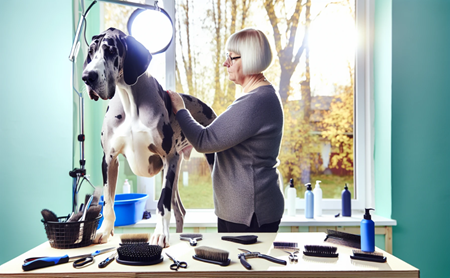
Before taking your gentle giant out, make sure they are physically and mentally primed for public outings, which include exercise routines, grooming, and desensitization techniques. A well-exercised and groomed pooch is more likely to be comfortable and well-behaved in public spaces, making it easier for both of you to enjoy your time out together.
Ensuring Your Great Dane is Physically Prepared
Great Danes require regular exercise for optimal health, such as a 30-minute walk daily, in addition to some time for running and playing. Grooming is also essential to ensure your large companion’s comfort during public outings. Great Danes of the Ozarks advises owners to brush their dog multiple times per week, especially during seasonal shedding.
Mental Preparation
Mental preparation is key for a successful outing with your majestic breed. Use desensitization techniques, such as exposure to different people, animals, and situations, to help your Dane develop confidence and adaptability when interacting with small dogs and other animals.
Positive reinforcement, such as praise and treats, will encourage good behavior and etiquette, making public spaces a wonderful place for both you and your canine companion. Catering to your pet’s mental needs guarantees a positive outdoor experience for both of you.
Space Awareness and Consideration
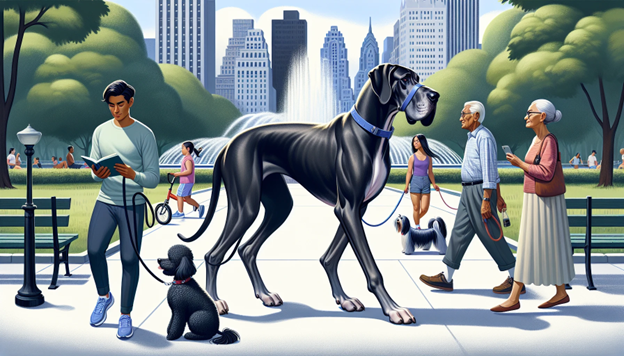
Being aware of your towering canine friend’s size and sharing public spaces respectfully are crucial for the comfort and safety of others. They are notably larger than many other dog breeds, making them an impressive presence in public settings.
Understanding Your Dane’s Size
Great Danes of the Ozarks explains that owning a large breed comes with challenges and responsibilities. Adult Danes can reach a height of up to 34 inches at the shoulder and weigh 150 pounds or more. Their size may draw attention, both positive and negative, and could make them difficult to control in certain situations.
Sharing Spaces Respectfully
Devin Harris of Joplin, MO says that teaching your giant dog to respect personal space and boundaries is essential for peaceful coexistence in public areas. Early socialization and training will help your Dane develop appropriate behavior and learn to respect the space of other dogs and humans.
Positive Encounters with Other Dogs
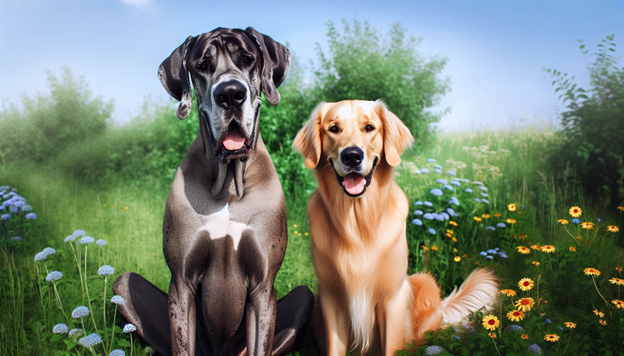
Securing positive interactions with other dogs is vital to uphold harmony in communal spaces. Understanding canine body language and correctly introducing dogs can help avert misunderstandings and conflicts between dogs.
Reading Canine Body Language
Dogs communicate primarily through body postures, facial expressions, and olfactory cues. Learning to interpret canine body language equips you to identify signals of aggression, fear, or unease in dogs, allowing you to intervene when necessary to avoid conflicts.
Introducing Dogs the Right Way
Proper introduction techniques are crucial for positive interactions between your Great Dane and other dogs. To introduce your large pet to another dog, proceed with caution and ensure both dogs are securely leashed. Walk the dogs parallel to each other at a distance of approximately 20 feet, gradually decreasing the distance while paying close attention to their behavior.
Great Danes of the Ozarks remarks that this methodical introduction allows the dogs, including your new puppy, to become acquainted with each other in a controlled and secure manner, setting the stage for a successful encounter.
Handling Distractions and Surprises
Training your Great Dane to handle distractions and surprises calmly is essential for a positive experience in public spaces. Unexpected events can cause stress or anxiety in dogs, which can lead to undesirable behaviors or even dangerous situations.
Training for Unexpected Events
Devin Harris of Joplin, MO notes that training your Great Dane to react calmly to unexpected events, such as loud noises or sudden movements, by following these steps:
- Begin with basic obedience training in a low-distraction environment.
- Gradually increase the level of distractions as your dog becomes more comfortable and confident.
- Use positive reinforcement, such as treats and praise, to encourage your dog’s calm response to distractions.
Staying Calm Under Pressure
Remaining calm and composed during unexpected situations is crucial, as your Dane will look to you for guidance. If you remain calm, your dog is more likely to stay calm as well. Provide comfort and reassurance to your dog, using a calm voice and offering treats or toys to divert their attention.
Visiting Dog Parks with Your Great Dane
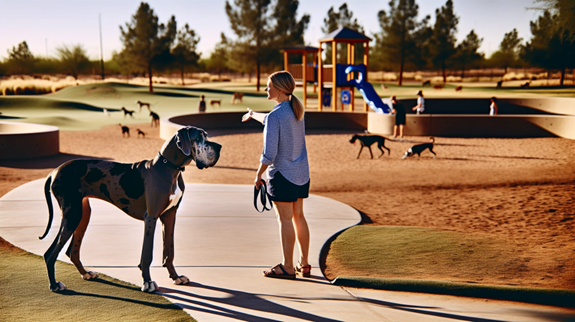
Dog parks can be a fantastic place for your Great Dane to socialize and burn off energy, but it’s important to assess the park layout and follow etiquette guidelines for large breeds.
Assessing the Park Layout
Before entering a dog park with your dog, evaluate the park’s size, layout, and suitability for your canine companion. Look for a spacious fenced area with a double-gated entry to prevent smaller dogs from slipping out. An accessible path from the parking lot to the park itself is also important.
Park Etiquette for Large Breeds
Great Danes of the Ozarks notes that following dog park etiquette specific to large breeds is essential for a positive experience. Monitor your pet’s play, ensuring it remains playful and not aggressive. Be respectful of smaller dogs’ space, as your big dog could accidentally hurt them during friendly play.
Dining Out with Your Gentle Giant
Enjoying a meal out with your Great Dane can be a delightful experience, but it’s important to prepare them for restaurant environments and respect fellow diners. By training your giant dog to behave appropriately in pet friendly restaurant settings, such as lying down quietly and not begging for food, and maintaining a clean dining area, you’ll ensure a pleasant dining experience for everyone involved. It’s also a good idea to call and ask the pet-friendly spot ahead of time if your large breed will be allowed. Some restaurants, although they are pet friendly, may have limits on the size of the breed for space reasons.
Traveling with Your Great Dane
Traveling with your Dane can be an enjoyable experience, but it’s important to follow car travel tips and find dog-friendly accommodations for your gentle giant. Ensure your noble partner’s safety and comfort during car travel with appropriate restraints and regular breaks.
Car Travel Tips
To ensure your Great Dane’s safety and comfort during car travel, provide appropriate restraints, such as the Joyride Harness. Take frequent breaks during car travel, pausing every two hours to allow your companion to stretch their legs and relieve themselves. Adhering to these car travel tips guarantees a safe and comfortable journey.
Finding Dane-Friendly Accommodations
Finding dog-friendly accommodations that cater to large breeds is essential for a successful trip. Research the area you’re visiting and review the pet policies of the accommodations you’re considering. Websites like BringFido and DogFriendly can help you find suitable lodging for your gentle giant.
Emergency Preparedness
Being prepared for emergencies is essential for the safety and well-being of your pet. Create an emergency plan and familiarize yourself with the signs of health emergencies, such as bloat, to ensure you’re ready to respond appropriately should the need arise.
Creating an Emergency Plan
Devin Harris of Joplin, MO notes that it’s important to develop an emergency plan for your Great Dane, including:
- Contact information for veterinarians and pet-friendly shelters
- Pet litter and litter box
- Newspapers
- Paper towels
- Plastic trash bags
- Household chlorine bleach
- A first aid kit with medical supplies
- Food and water for the dog
- Information regarding the dog’s insurance policy (if applicable)
Having an emergency plan in place will give you peace of mind and ensure you’re prepared for any unexpected events.
Recognizing and Responding to Health Emergencies
Learn to recognize signs of health emergencies in your giant friend, such as bloat, which may include a swollen, firm abdomen, retching without being able to vomit, and labored breathing. If you suspect it has bloat or is experiencing another health emergency, act quickly and seek veterinary attention immediately.
Identifying and reacting to health emergencies could potentially be a lifesaver for your Great Dane, and knowing when to contact an emergency vet is crucial.
Summary
Mastering Great Dane etiquette is essential for ensuring their safety, comfort, and the respect of those around them in public spaces. By following the guidance provided in this blog post, you’ll be well-prepared to enjoy outings with your gentle giant while maintaining harmony with other dogs and people. Remember, practice makes perfect, so be patient and consistent in your training efforts. Happy adventures with your Great Dane await!


